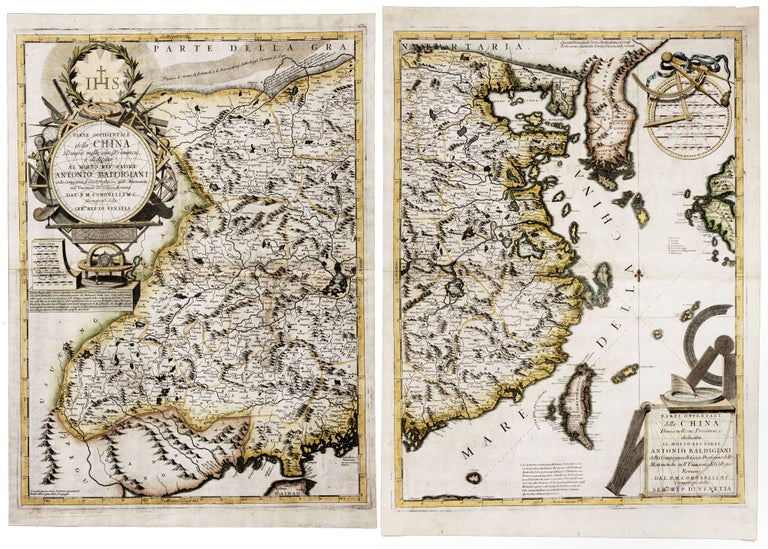
Parte Occidentale della China . . . / Parte Orientale della China . . . Two sheets, 23 ¾ x 36 inches (60.3 x 91.4 cm) each. Excellent condition with dark, rich impression. Hand-colored in outline. With text in Italian on verso.
Two sheets, 23 ¾ x 36 inches (60.3 x 91.4 cm) each. Excellent condition with dark, rich impression. Hand-colored in outline. With text in Italian on verso. An important map in a striking example that provides one of the finest specimens of Coronelli’s robust engraving style. In addition to being a state-of-the-art depiction of China, it also serves a visual compendium of the tools of a seventeenth-century surveyor and cartographer. The precisely engraved instruments decorating the map are a tribute to the technical skills of the Jesuit missionaries, whose surveys formed the basis of the map. The map comes from Coronelli’s Atlante Veneto, a comprehensive thirteen-volume atlas, published between 1690-1701. Coronelli dedicated the map to Antonio Baldigiani (1647-1711), a Jesuit and Athanasius Kircher’s successor as the Professor of Mathematics at the Jesuit Collegio Romano. From 1691, Baldigiani served as a consultor to the Sacred Congregation of the Index—a Church body responsible for censoring publications that were seen as dangerous to Catholic faith. In this role, he was a rather important liaison between the rapidly developing scientific world and the Church. The Jesuits played an active role in China, seeking opportunities to display their technical skills and scientific knowledge to Chinese intellectuals. They believed that if Chinese intelligencia could be persuaded of the superiority of Western learning, they might also influence those in power toward converting to Christianity. One of the most dramatic means of making such a demonstration was the creation of maps, some of them actually printed in China and in the Chinese language; some were of enormous size to heighten their impact. Perhaps Coronelli had it the mind that this map could be used in the fashion described above by his fellow clergymen. (Coronelli himself, however, was not a Jesuit; somewhat surprisingly, given his worldly achievements and the powerful circles in which he traveled, he was a Franciscan.) Coronelli based his map on an earlier map by the Jesuit Philippe Couplet (1623-1693), published in his Tabula chronologica Monarchiae Sinicae (1686). “While Couplet had freely taken information from his other Jesuit confreres, he still kept to the Ming division of China into 15 provinces years after the creation of three move provinces in the Qing. The map apparently came to the attention of cartographer Marco Vincenzo Coronelli, who in 1690, published a version of it in Venice. Coronelli’s map depicts Shandong and Beijing as province of China, and while strictly speaking Beijing is a city in Hebei province, the map is noteworthy for its inclusion of the area of the glassmaking center of Yanshen in Shandong” (Curtis, p. 68). Coronelli was arguably the most important mapmaker of the late 17th century and probably the most productive as well, having published over 500 maps in his lifetime. At the same time, he rose to the position of General of the Franciscan order at the beginning of the 18th century. It is likely it was through his dual roles as cartographer and powerful clergyman that he was able to obtain the information that allowed him to produce such a fine map of China. As a cartographer, Coronelli carried on a wide-ranging correspondence with explorers and scholars. And as a senior clergyman, he most likely had access to geographical information on China obtained by missionaries. In any case, Coronelli’s mapping of China was superior to anything available in its day. In addition to all of this, Coronelli is also regarded as one of the finest early globe makers. His reputation in this field was secured by a pair of globes he made for Louis XIV that measured 15 feet in diameter and became one of the wonders of the monarch’s court. Coronelli is also credited with having revived both the craft of engraving and the study of geography in his native Venice. *“Coronelli, Vincenzo Maria,” in The History of Cartography, Vol. 4, pp. 316-319; Curtis, Glass Exchange between Europe and China, 1550-1800 (2017).
Price: $8,750.00
